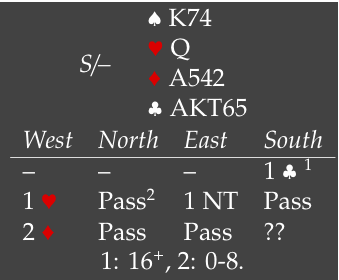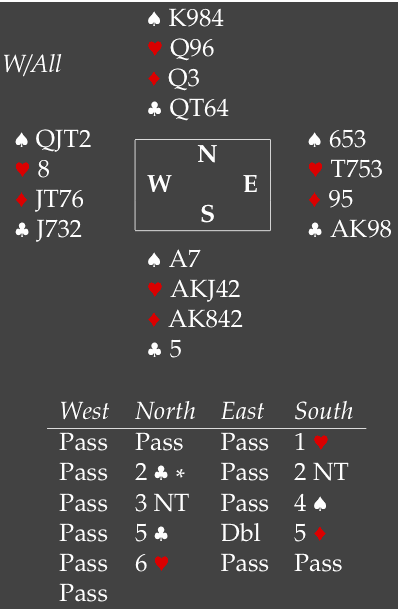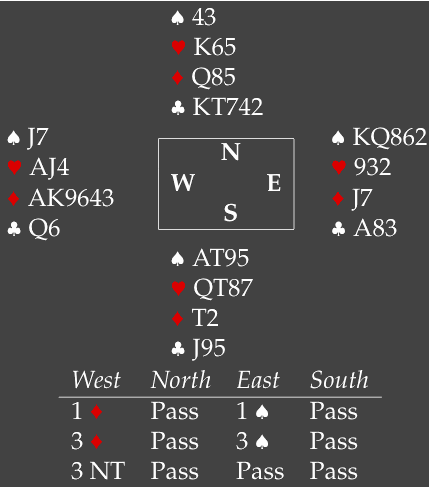 As promised, the solutions of the hands from the Junior Day at the Denktank last Saturday, click here for the full report on the event. The hands are originally from the finals of a Dutch National Championship in the early 2000’s, so you may recognize them from some where. The original questions are typeset in yellow.
As promised, the solutions of the hands from the Junior Day at the Denktank last Saturday, click here for the full report on the event. The hands are originally from the finals of a Dutch National Championship in the early 2000’s, so you may recognize them from some where. The original questions are typeset in yellow.
 Nobody vulnerable, you open a Precision club (16+, almost any distribution) in first seat and the auction proceeds as follows. Your turn to bid something?
Nobody vulnerable, you open a Precision club (16+, almost any distribution) in first seat and the auction proceeds as follows. Your turn to bid something?
Let’s see: you have a bare minimum in high cards, some people would not even count the ♥Q for 2 points. Partner can be broke as he failed to act at his first 2 turns. Your side does not have to have a fit, consider the case where east has a 4-2-3-4 shape or similar. Finally, you have 4 or 5 defensive tricks. In favor of bidding is that this is a low level partscore and even if EW have 8 trumps, defending is not a good idea. So, at best it looks like a toss-up between passing 2♦ or doubling for take out. For what it is worth, I polled a few players and all passed, though double was mentioned as an alternative.
 Of course, the real auction was different as can be seen on the left. Partner broke tempo before passing 2♦. This makes a huge difference, partner will have some values and doubling will almost always be a success. Either partner can convert to a penalty double and if he bids a black suit, that will have some play too.
Of course, the real auction was different as can be seen on the left. Partner broke tempo before passing 2♦. This makes a huge difference, partner will have some values and doubling will almost always be a success. Either partner can convert to a penalty double and if he bids a black suit, that will have some play too.
Of course, you will not get away with this, if the break in tempo suggests one action over another, the laws clearly state that is not allowed to select that action.
At the table, north showed up with a 7 count and bid 2♠. That was just right in level, as there was no real fit and a lot of pairs overbid the NS hand. 2♦ would have made on the spot, so there was a huge difference in matchpoints.
 Vulnerable against not, you pick up this collection. Partner is an expert player but you haven’t played with him before. First, is this an opening bid and if so what? If you think the hand is too flawed for any of the preempts, the bidding starts with 1♣ on your left, pass from partner, 1♥ on your right. Your turn?
Vulnerable against not, you pick up this collection. Partner is an expert player but you haven’t played with him before. First, is this an opening bid and if so what? If you think the hand is too flawed for any of the preempts, the bidding starts with 1♣ on your left, pass from partner, 1♥ on your right. Your turn?
Traditional wisdom has it that an opening preempt denies a 4 card major. I still consider that a good principle, so 3♦ (or any other diamond preempt) is out of the question for me. It does create a problem on the next round though, a weak jump to 3♦ seems about right on strength but it will make partner wonder why you didn’t open 3♦. I checked literature and, oddly enough, none of the “standard” works on preemptive bidding discuss the topic of passed-hand preempts in any detail. Usually, the discussion doesn’t go much further than “suitable for bidding at this level, but with some flaw that made it impossible to open with a preempt”. Great, but does this have to do with distribution, suit-strength, a side suit or what? For serious partnerships, here is work to be done.
 An opening lead problem. You and partner pass, the opponents bid a simple 1♥-2♥-4♥. 1♥promises 5, 2♥ is constructive. Your lead as North?
An opening lead problem. You and partner pass, the opponents bid a simple 1♥-2♥-4♥. 1♥promises 5, 2♥ is constructive. Your lead as North?
With 2 weak trumps, going for a club ruff is not a good idea. Unless partner has something as specific as ♠AK, by the time you have gotten rid of your 2 clubs, declarer will have drawn trumps. It is a better to set up a trick or so in a side suit. The obvious candidate are the diamonds, so you lead one. Right?
I think everybody is familiar with attitude leads and “upside down” attitude. In both cases, that implies that a low card encourages, and that is a nice similarity. Also well known are Roman Signals, aka Odd-Even: An odd card encourages, an even one is suit preference. Why can’t you play this for opening leads as well, a couple of creative juniors must have thought. Their opening leads were thus: an odd card shows strength in the suit lead, an even card shows strength where you don’t want to lead the suit. The problem with this approach can be seen on this hand. North wants to lead a diamond, but he can’t as the ♦6 suggests spade values and ♦2 clubs. The “solution” is to lead another suit with suit preference. But that doesn’t always work, as can be seen on this hand. A spade lead knocks out the entry before the diamonds are set up, a club lead gives declarer a free finesse.
A creative but not a good idea.
Somebody later told me that this convention is known as OPEL, for Odd Positive and Even Lavinthal. The name doesn’t make it a good idea though. For those who played and don’t recognize the hand, that is correct, it has been modified a bit to stress the point.
 You, south, are in 6♥ on a club lead. 2♣ was Drury, 2NT showed any slam try, 3NT a balanced minimum, 4♠ asked for aces, 5♣ showed none, 5♦ asked for the ♥Q, 6♥ showed that card. South leads the ♣3, 3rd and 5th, ♣4, ♣K, ♣5. North returns a heart. Plan the play.
You, south, are in 6♥ on a club lead. 2♣ was Drury, 2NT showed any slam try, 3NT a balanced minimum, 4♠ asked for aces, 5♣ showed none, 5♦ asked for the ♥Q, 6♥ showed that card. South leads the ♣3, 3rd and 5th, ♣4, ♣K, ♣5. North returns a heart. Plan the play.
This hand is interesting from both declarer’s and defenders point of view. The first trick is obvious, but then what should east return. It is safe to assume that declarer has a singleton club, otherwise his bidding does not make sense. A club return will thus set up a trick in that suit and that can be the 12th trick if declarer has something like Axx/AKJxx/AKJx/x. What else does declarer have? Probably a diamond suit on the side that he has to set up by ruffing one or more diamonds. This suggests a heart return in order to shorten trumps. However, returning a heart from ♥108xx might cost a trick. Still, it seemed like the best bet.
Now look at it from declarer’s point of view. He can run the trump return to the ♥Q9, picking up the 10 if necessary. Then 2 top diamonds and a diamond ruff with the ♥Q will set up the diamonds if that suit breaks 4-2 or 3-3, and the contract is made even if trumps split 4-1. And all this because of the trump return. It almost looks too good to be true.
In practice, declarer didn’t believe his luck and went for another line: a dummy reversal. That didn’t quite work with the 4-1 trump split. Note that with the actual layout, any card but a trump at trick 2 will defeat the contract.
 Partner north leads the ♥5, 3rd and 5th, ♥2, ♥Q, ♥A. Back comes the ♠J, ♠4, ♠2 and it is your turn to play a card. Carding is standard, high-low showing an even number.
Partner north leads the ♥5, 3rd and 5th, ♥2, ♥Q, ♥A. Back comes the ♠J, ♠4, ♠2 and it is your turn to play a card. Carding is standard, high-low showing an even number.
What is declarer trying to do here? He is likely to have 6 good diamonds and a 5-2 spade fit; with 3, declarer would have supported, with the ♠J singleton, partner has ♠743 and would not have played the ♠4 (but the ♠3). Why would he attack the spade suit first? The reason is, of course, that declarer is trying to steal a trick before playing on diamonds. And so it proved, when south routinely ducked the spade, declarer gave up a diamond and claimed 9 tricks.
